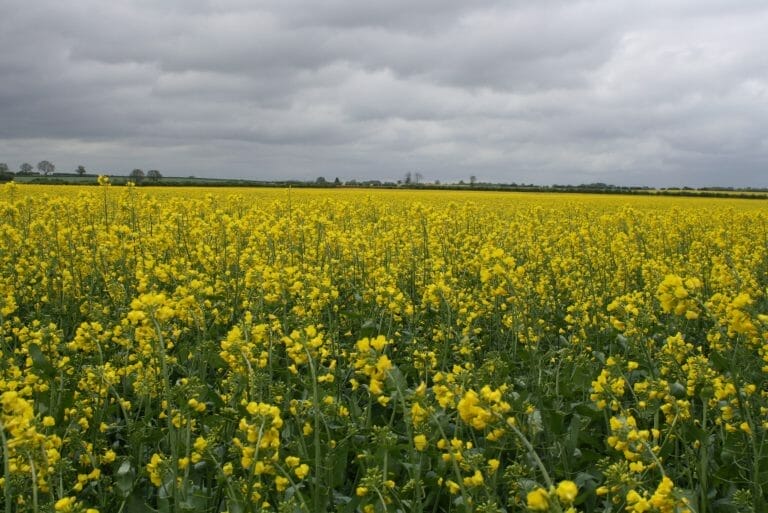
Liam Wilkinson introduces Limagrain’s newest genetic trait, Sclero-flex, into its OSR breeding lines.
Sclerotinia stem rot is a significant disease of oilseed rape in the UK; and in some circumstances, can reduce yields by 50% or result in complete loss through plant death.
In spring, when soils are moist and warm (10oC+), sclerotia in the soil germinate, releasing airborne ascospores which land on OSR petals. Sclerotinia then develops as the petals fall and stick to the leaves or stems, assisted by further moisture.
The disease is fed by nutrition from the rotting petals and pollen, allowing penetration of the leaf cuticle, resulting in lesions. Then, stem lesions occur as the pathogen spreads, which reduces food and water supply to the canopy, induces premature ripening, and weakens stems to cause lodging.
Effective control of the disease relies largely on protectant fungicides that should be applied during mid-flowering before there is any significant petal fall. However, the fungicides only have a protectant role and have to be applied ahead of infection taking place.

Coretta Kloeppel – OSR Hybrid Breeder
Sclerotinia sprays can coincide when on-farm activity is high and there’s greater pressure on sprayer hours. This makes it difficult to hit those optimum timings.
Sclerotinia is the reason given for almost 30% of total fungicide use in the crop. Against this background, the weather has become less predictable.
In recognition of this increasing threat, a new breeding tool has been identified by Limagrain to help combat the disease. Known as Sclero-flex, this exciting quantitative tolerance to Sclerotinia completes the Sclerotinia control triangle, joining cultural methods and fungicidal chemistry.
Limagrain OSR varieties with the new technology, have shown an average reduction in Sclerotinia incidence of 57%, and a reduction in severity of 44%.
How does Sclero-flex work?
It’s based on tolerance rather than resistance. Sclero-flex is the collective result of many smaller genes which all demonstrate tolerance. This ensures a variety will be durable and sustainable and less likely to break down in the future.
The focus on developing new traits beyond existing scope has been coined as Limagrain’s seventh generation of hybrids – bringing varieties to the market which offer a stacked portfolio for stem health, alongside the standard pod shatter, TuYV and RLM7 resistance traits, which growers have come to expect.
LG Armada is the first seventh generation hybrid to be released, boasting the new Sclero-flex technology. It’s also the highest yielding OSR variety on the AHDB Recommended List.
Integrated Pest Management Foundations
Plant breeding remains the foundation of integrated pest management (IPM).
LG champions a ‘control triangle’ where effective disease management lies in a careful balance between cultural practices, responsible fungicide use, and refined plant genetics. This includes when combatting Sclerotinia.
Cultural control practices rely on widening the cropping rotation – so, only growing OSR once every five years, whilst being mindful of where other Sclerotinia hosts fit into the rotation. Effective weed management is also important.
As for responsible fungicide use, action starts by using relevant Sclerotinia alert tools such as that hosted by the AHDB. It’s then a case of understanding the crop’s growth cycle and not using fungicides curatively, due to them having no activity once infection has taken hold.
Breeders Perspective Q&A
Maeve O’Rourke – Junior OSR Breeder
Q. What diseases do you see as being the biggest threat to UK OSR crops in the coming seasons?

Maeve O’Rourke – Junior OSR Breeder
A. I think it’s still going to be cabbage stem flea beetle that will be our biggest challenge rather than disease.
LG has a huge selection of different varieties with robust resistance against common UK diseases, with dozens of strong varieties in the immediate pipeline, and international research behind upcoming challenges. However, fighting CSFB is a unique and hard challenge for breeders and farmers alike.
Q. How important is the UK to the European breeding programme?
A. The UK is extremely important.
Almost every parent line in the last two decades has begun at our head office in Rothwell, Lincolnshire and our trials network is so varied (from Aberdeen to Dorset and everywhere in between) that we have a great chance of spotting any future issues for disease and any stand-out varieties, not just for the UK but all of Europe.

Q. As a breeder, what is your focus for the future?
A. Focusing on different sources of resistance.
As breeders, we know we have a limited lifespan for all resistances because diseases are constantly evolving, and the changing long-term climate conditions will affect where in the UK these diseases start to occur. We are always looking to find new and novel types of resistance, even if they aren’t useful in 2024, they might be crucial in 2034.


































